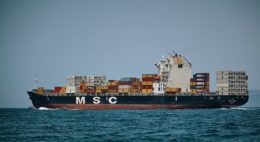
Logistics 101: Tantlinger’s Twist Lock
A simple device invented in the mid-1950’s paved the way for containerization and global trade as we know it today. In this article, we are taking a look at Tantlinger's twist-lock and its groundbreaking implications on global trade.

Most of the products that you can buy in stores or that are delivered to your doorstep have travelled through a global supply network that only emerged in the 1950s. As over 90% of the world’s trade is carried by sea, it is very likely that your clothes, items of furniture and food have all been hauled to you while packed in a steel container.
This method of transporting goods used to be highly time-consuming, labour-intensive and expensive. In his book “The Box: How the Shipping Container Made the World Smaller and the World Economy Bigger”, the author Marc Levinson describes that a cargo ship that left the US for Germany in the 1950s often carried close to 200,000 separate items. These had arrived at the docks in over 1,000 separate shipments and then had to be loaded by stevedores onto the ship.
Keith Tantlinger’s Twist-Lock
The idea of shipping cargo in sealed containers has already been in practice since the 19th century. But for a long time, it lacked a safe technique to build tall stacks of containers to efficiently scale up transportation capacity.
In the 1950s, Keith Tantlinger invented a mechanism, the twist-lock, that was added to all four corners of a container that allowed a second container to be stacked on top and locked the two together at the same time. These simple refinements further allowed containers to be safely lifted and lowered onto ships by cranes and transferred from cargo vessels to trains and trucks.
How does the twist-lock work exactly?
In his patent filing, Tantlinger described his invention as a “coupler (that) has a housing with bosses on opposite ends which journal a rotatable element within the housing”. As the video above shows, twist-locks are placed at each corner of the container and can be locked securely to other containers by merely turning a handle. A second container can be lowered onto the coupler and be automatically (dis-) engaged. As this operation can be repeated multiple times, it allows to build taller stacks of containers. Something we are quite used to seeing in ports and on cargo vessels nowadays.
To allow widespread adoption of his invention, Tantlinger eventually released his patent royalty-free, which led to Tantlinger’s twist-lock being recognized as an international standard. Today, the corner eyelets are also utilized by cranes to safely load and unload ships as well as by trains and trucks that similarly secure the container by latching onto the twist-lock.
Containerization unified the process of moving goods across sea and land, as it allowed to ship goods long distances at low costs. It replaced the manual (un-) loading of cargo and its low costs ultimately paved the way for globalization as we know it today.

